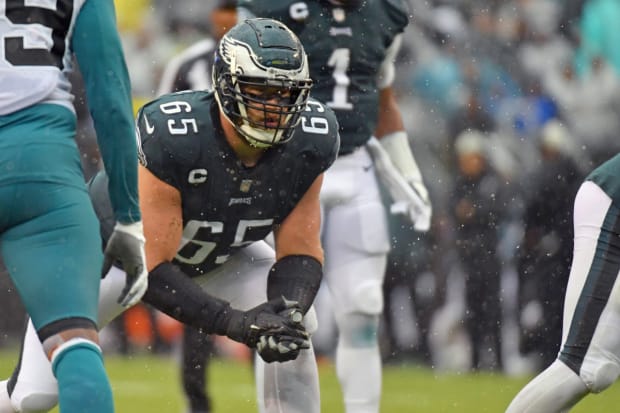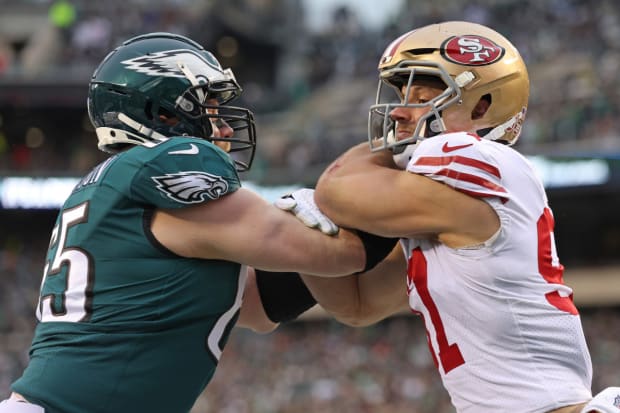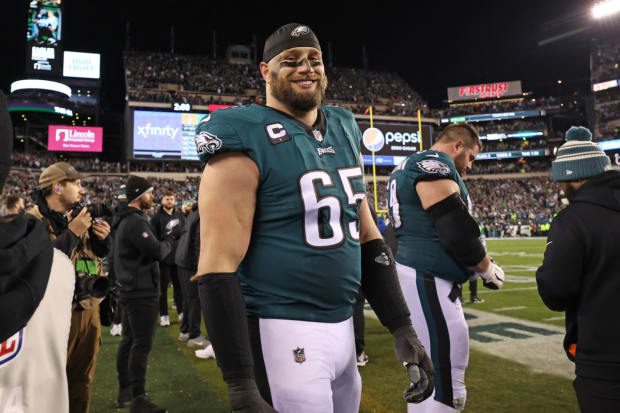It is a third-and-8 near midfield. There are three seconds left on the play clock.
The optical illusion is about to be on display.
Jalen Hurts throws his hands in front of his body, uttering the final syllables of the Eagles’ presnap cadence, demanding the football. Everyone on offense is still, as if frozen in time beneath the pumice of Mount Vesuvius. Everyone, that is, except for Lane Johnson.

Eric Hartline/USA TODAY Sports
With the ball still tightly gripped in center Jason Kelce’s hand, the Eagles’ star right tackle is already working his way back into his passing set. Johnson’s left leg is kicking backward, and, by the time the ball reaches Hurts in the shotgun, Johnson has retreated almost three full steps from the line of scrimmage. It gives him an almost insurmountable advantage against the 49ers’ pass rusher, Nick Bosa, whom Johnson is blocking almost exclusively during the NFC title game, with little assistance. On this first-quarter play, he successfully shields Bosa from Hurts for another play. Bosa, the odds-on favorite to win the 2022 NFL Defensive Player of the Year award, will finish the game without a single quarterback hit.
Online, there is another familiar refrain of calls from the slow-motion police and referee watchers: Johnson is good, because he false starts on every single play. But what if the inverse was true? What if Johnson is so good that it simply looks as though he is leaving early on every snap?
“A similar thing happens with Jason Peters,” Johnson says of his former teammate and current Cowboys offensive tackle. “He’s always the first guy off the ball. That’s why he’s a Hall of Fame left tackle. He developed that.
“But everything we do is based off timing with Jason Kelce. That’s my job. If people were in my position they’d be doing the same thing. If you don’t you’re going to get toasted.”

Bill Streicher/USA TODAY Sports
This year’s Eagles are an amalgam of success stories. Schematically, they are ahead of most of the NFL. From an administrative standpoint, their owner and general manager have consistently out-thought, out-drafted, out-traded and out-hired most of the NFL. They have a rising, dual-threat star at quarterback. An amoebic defense. One of the best wide receiver tandems in the league.
But much of that becomes moot if not for Johnson, the 32-year-old who was drafted by the franchise in 2013 out of Oklahoma. Against the 49ers, Johnson was essentially playing one-legged, forcing himself on the field amid a severe injury to his adductor muscle that will eventually require surgery. By unofficial count, he received assistance from other Eagles blockers only three times.
That meant on that Sunday, and through most of this season, the Eagles have been able to use those extra blockers to aid other offensive linemen, or use those eligible in the passing game to flood already overwhelmed defenses with more pass-catching options. Johnson is one of the best run blockers in the NFL. He’s one of the best pass blockers. One big reason? He flies off the ball.
“[Lane’s speed] plays into what he does well,” says Geoff Schwartz, a retired lineman who played eight NFL seasons. “Lane is so big. And so if you can get in front of a defensive end, it takes away what the end can do well. Defensive ends want to rush the edges. They want to get around you. But when Lane gets off the ball so fast, he’s able to get square and centered. It eats up anything a defensive end wants to do.”
Andrew Whitworth, who played the position for 15 years in the NFL and was twice named First Team All Pro says this is not new; Johnson’s speed was known in league circles for years. The fact that it has risen to conspiracy-theory levels because of the success it has provided him is what makes the entire thing worth dissecting. Upon rewatching the 49ers-Eagles game pretending to be a lay fan watching the broadcast angle, for example, it appeared that Johnson left the line of scrimmage early on 14 of his 60 offensive snaps.
According to Schwartz and Whitworth, the real story is far more interesting.
Watch Super Bowl LVII live with fuboTV: Start a free trial today.
• Johnson has a great relationship with center Jason Kelce. For instance, when the Eagles are on the road and utilize a “silent” snap count—which is at the discretion of the center—Johnson is so intimately familiar with Kelce’s smallest movements that he is able to time his own motion pattern based on how long it typically takes Kelce to begin the process of snapping. “Ten years of the same rhythm,” Schwartz says. “If you have a center that’s good, you can start to see him begin his cadence, then you can turn right toward the defensive end, and by the time that happens the ball should be legally snapped. Maybe it’s a head bob. Then you just turn toward the defensive end. You don’t even need to see the ball snapped.”
• Johnson has a great relationship with Hurts. Whitworth says that the offensive tackle position can be the most advantageous spot on the offensive line for players wanting to get a jump. It is the easiest spot at which to hear a quarterback, at a kind of 45-degree angle (Johnson’s left ear, for example, is directly facing Hurts’s mouth) than it is for a center or a guard to hear a call. Hurts can—and seemingly does—take care of his right tackle by being loud and consistent with his calls directionally.
• Because of this ingrained camaraderie and Johnson’s innate quickness, he has found the perfect slit of time in which to fire up his body and start moving. As Duke Manyweather, an offensive line trainer who works with some of the sport’s best talent, noted during an online post tamping down the conspiracy: Players in a two-point stance are allowed to adjust their back foot before the snap. That is not considered a false start. Johnson knows this and can, essentially, blend the good intel he already has from his center and quarterback, with the timing of a faux adjustment of his back leg. The adjustment, then, becomes an actual step, which allows Johnson to hunker into his pass set quicker.
Or, as Schwartz puts it: “If the speed limit is 40 miles per hour and you’re going 45 miles per hour and you don’t get pulled over, are you speeding?”

Bill Streicher/USA TODAY Sports
This is where Johnson exists, in perpetuity. He is, all at once, too fast and just fast enough—a window in which officials won’t throw a flag, fearful that they would have to throw similar penalty flags on almost every down in every game (and make a three-hour game bleed into Lord of the Rings territory).
Johnson has been called for only three false start penalties this year, and two in each of the previous three years. For comparison, 32 other offensive tackles were called for at least four false start penalties in 2022, with Laremy Tunsil of the Texans leading the league at 7.
This is what being one step ahead in the NFL looks like.







